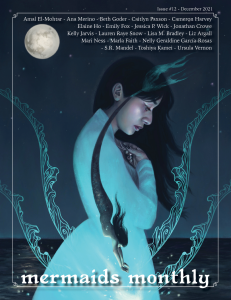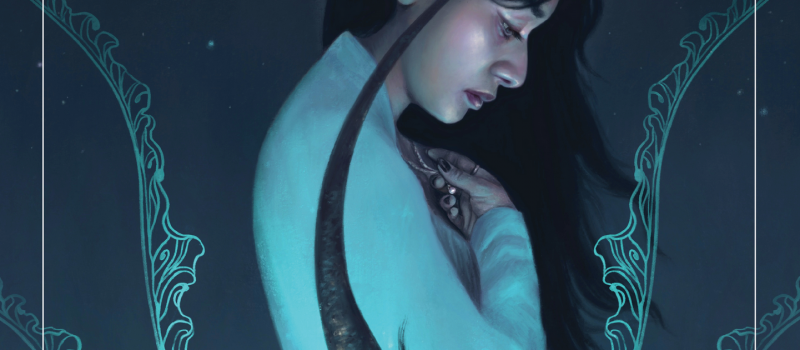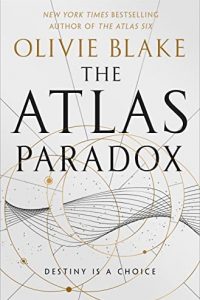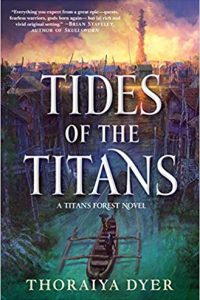Charles Payseur Reviews Short Fiction: Anathema, Mermaids Monthly, Zooscape, and FIYAH
 Anathema 12/21
Anathema 12/21
Mermaids Monthly 12/21
Zooscape 12/21
Fiyah 12/21, 1/22
Every year a few publications put out issues on December 31, and 2021 was no exception. Aside from Baffling Magazine, which I looked at last column, both Anathema and Mermaids Monthly released their December issues on the final day of the month and year, and while that might make them easy for busy readers to miss, both are very much worth checking out.
Anathema’s December issue opens with a touching editorial from Andrew Wilmot, celebrating five years in operation and touching on the complicated and important notion of communities, especially in Times Like These. The issue lingers on that idea of community, exploring relationships, isolation, loneliness, and survival across five short stories and two poems. Megan Navarro Conley’s “The Taurus Plot” looks at a mech pilot who feels alone even in a military full of people in their same situation – academy-trained to remotely embody weapons of enormous power. For the pilot, though, the only connections that really ground them are the ones to their suit and to a fellow pilot, and both of those seem poised to come untethered in short order. For fans of mech suits, this piece doesn’t really offer up the big action or fight scenes, but rather brilliantly zeroes in on the fragility and humanity of those asked to really become the weapons they use, and then stop when their superiors tell them to.
Ada Nnadi’s “Dearest” also deals with school, but keeps things a bit more contemporary as a young woman, Kasie, tries to figure out herself and her sexuality during the pandemic. Having to make do with online connections while her in-real-life friends turn on her, Kasie is vulnerable and trapped. That is, until one incident of bullying when she makes a connection with a mannequin that is more than it seems. The story captures the mixture of horror and hope that is so many people’s reality as they navigate coming out, alone and desperate for something they have no idea how to safely look for, tracing the outline of a chasm they could easily fall into, or rise above. The piece has a captivating energy to it, even as I find most evil doll/mannequin stories incredibly creepy. Closing out the issue, “Semsema of the Zabbaleen” by Ramez Yoakeim also deals with a young person alone and vulnerable, this time a child cut off from her family, living as she can by charity and selling trash, avoiding authorities who want to forcibly relocate her and balancing foreign “aid” that comes with its own dangers. For her, hope becomes a tree that she nurtures into growth despite the harsh and climate-change-ravaged reality of her home.
Mermaids Monthly was originally imagined as a limited project, but I admit when it was announced that the editorial team would be handing things off to a new group of mermaid enthusiasts, I was excited that the publication would continue. Especially in its PDF format, the issues capture a wonderful ’zine aesthetic and style, the layout and design work walking hand in hand with the strong fiction, poetry, and art. So it’s bittersweet news that the crowdfunding campaign for the second year has been suspended as the editors consider their options. It means that this December issue might be the penultimate one, at least for now. The sweet part is the issue is gorgeous, focusing on mermaids out of their normal habitats. From cold weather mers to fresh water varieties, the works expand the borders for mermaids, from the historical past to the far reaches of space.
An interesting example of bending style and expectations is the interactive quiz “Which Inland Waterways Merfolk Are You?” by Nelly Geraldine García-Rosas & S.R. Mandel, which allows the reader to answer a series of questions to find out what kind of mer they are. The worldbuilding is subtle and fun, focusing in a more scientific and naturalist classification of mermaids rather than using a magical lens. It goes great with the fun-facts feel of Ursula Vernon’s educational single page comic, “The North American Wombat’s Guide to Random Sea Creatures“. For those wanting to know more about the noble sea hare, it’s delightful. And though I mostly cover short fiction for this column, I have to mention the long poem “The Catfish Sisters” by Lisa M. Bradley, which follows some harrowing historical events with a fantasy twist as a community of sea creatures decides to act in the face of racist violence polluting their home, the Mississippi River.
Another December release that might have flown under many people’s radar is Zooscape’s thirteenth issue. The publication has been seeking to raise the profile of furry fiction, and this issue’s introduction lays a bit of that groundwork, removing some boundaries and borders from what has often been a rather maligned subgenre. In practice, that means defining more of what furry fiction is, and what it can be, and identifying the works already out in the speculative fiction landscape that definitely qualify as furry. So there’s a reprint of Naomi Kritzer’s talking cat story, “A Star Without Shine“, next to new original works featuring sentient dragons, horses, crows, and more.
“Rabbitheart” by Archita Mittra, for instance, follows a small rabbit who risks everything to try and repay a debt of friendship, learning along the way the boundaries of life and death and the importance of kindness. The piece is framed as a fairy tale and carries with it both the hard grimness of death and loss and the reaching for a happy ending. M.H. Ayinde takes a more humorous approach to furry fiction in “Scale Baby“, imagining a suburbia where dragons are the new hot pet but where the dragons themselves (think cats but with the ability to burn a lawn chair to cinder in three seconds) are contemplating changing the nature of their relationship with humans. And in “A Chance to Breathe” by Daniel Ausema, a beetle, Tirkit, arrives in a city of birds hoping for fresh air, only to find debt and pollution acting as bars on a prison she longs to be free of. Chronically ill in a city ruled by class restrictions and prejudices, Tirkit comes to rely on the kindness of those at the bottom of society when those at the top prove their callousness and greed. It’s a careful and determined look at what it can take to break destructive cycles and get people cooperating against an unjust system.
The last of the 2021 content I’ll be looking at is the special Palestinian Solidarity Issue put out by Fiyah. The issue is part of the publication’s solidarity pledge with the people of Palestine, and is curated, edited, illustrated, and features solely works by Palestinian creators. Across six short stories and nine poems, the issue comes alive with magic and language. Sonia Sulaiman’s “Muneera and the Moon” finds Muneera, a djinn, rising up to the mortal world to tell the moon her woes, her complaints of loneliness and yearning, all without realizing that the moon might actually be listening. Blending magic and romance, the piece finds a beauty and weightlessness even amidst heavy elements of loss, death, and intolerance. In Elise Stephens’s “First Leaf“, two women conspire to break the chains put on them by a society that has twisted the magic of a fig tree, whose fruit grants one person a year of invulnerability, into a violent race to plunder the fruit. They push through the proud assertions that women can’t enter the race to find a truth for themselves that has the potential not only to give a young woman a chance to pursue her dreams, but to reveal the cracks of injustice already weakening the structure of the entire city. It’s a powerful moment of generational community and aid, and its defiance and triumph make for compelling reading. Not that the issue doesn’t engage deeply with some troubling and unsettling narratives. Sarah Risheq’s flash fiction “rise” finds the narrator underground, buried for their own protection, with only one other person in the ground with them. Both of them are waiting for when they can rise, when it will be safe, but on and on the seasons pass as they remain suspended, planted. It’s a chilling and claustrophobic tale that finds safety a seed waiting far too long to sprout and flourish.
Moving into the new year but staying with Fiyah, the 21st issue of the publication marks their first since winning the Best Semiprozine Hugo Award in December. The issue doesn’t have a theme, but it is full of some interesting takes on rather classic speculative fiction elements – teleporters, time travel, and much more. “The Brief Life Story of Lila” by Danny Cherry Jr. explores the life of a kind of prophet, a woman who can see when and how a person will die by touching them. It’s a skill that at first distances her from people, her personal tragedies making connections dangerous, frightening. And yet as she finds people she wants to be with, she finds her life becoming almost… normal – until tragedy once more tips her into uncertainty, hurt, and longing. The piece is beautiful but not easy, and manages to be unexpected despite its focus on knowing the future. In Jendayi Brooks-Flemister’s “The Way Things Are“, the classic speculative element is shape shifting, as Nandi hopes she’s found lasting romance on the dating site BeastFinder, which connects people who can shift. The reality of the dating app, though, and of Nandi’s new relationship, turn out to be much different than she thought, and the piece doesn’t pull back from the visceral and violent legacy of werewolf fiction. Yet in the marriage of technology and magic there’s a great new wrinkle on things, and all new ways to hunt.
Recommended Stories:
“First Leaf”, Elise Stephens (Fiyah 12/21)
This review and more like it in the March 2022 issue of Locus.
 While you are here, please take a moment to support Locus with a one-time or recurring donation. We rely on reader donations to keep the magazine and site going, and would like to keep the site paywall free, but WE NEED YOUR FINANCIAL SUPPORT to continue quality coverage of the science fiction and fantasy field.
While you are here, please take a moment to support Locus with a one-time or recurring donation. We rely on reader donations to keep the magazine and site going, and would like to keep the site paywall free, but WE NEED YOUR FINANCIAL SUPPORT to continue quality coverage of the science fiction and fantasy field.
©Locus Magazine. Copyrighted material may not be republished without permission of LSFF.







